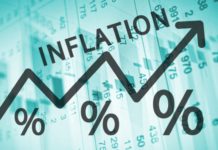The inflation rate for July 2018 declined to 9.6% compared with the rate of 10% recorded in June this year.
The monthly change rate in July 2018 was 0.4%, compared with the rate of 1.0% recorded in June 2018.
Non-food inflation
The main price drivers for the non-food inflation rate were Clothing and footwear (15.0%), Recreation and Culture (13.4%), Furnishing, Household and Equipment and Routine Maintenance (12.5%) and Miscellaneous goods and services (12.0%).
Food inflation
The price drivers for the food inflation rate were Coffee, tea and cocoa (11.3%), Fruits (9.7%), Meat and meat products (8.6%) Mineral water, soft drinks, fruit and vegetable juices (8.4%), vegetables (8.4%) and food products (7.7%).
Regional breakdown
Five regions – Upper West, Brong Ahafo, Western, Ashanti and Northern regions recorded inflation above the average of 9.6%.
Upper West region recorded the highest year-on-year inflation rate of 11.5%, followed by Brong Ahafo region (10.5%), while the Upper East region recorded the lowest year-on-year inflation of 7.8% in July 2018.
Rebasing
The Ghana Statistical Service has missed the target date for the release of rebased figures for inflation.
According to the acting Government Statistician, Baah Wadieh, stakeholders have made inputs into the methodology and some of the figures which need to be incorporated.
He said, “…so because of quality we think we must hold on and look at the figures, look at the methods, look at the procedures and then come out with the best that we can for the nation. They (stakeholders) are satisfied, in fact, they commend us at the rate at which we have worked but there is always the possibility of improving and that is what we are taking on board.”
However, the GSS is expected to release the new rebased figures by the end of this month.







